Terrazzo vs. marble – two beautiful stones that are used frequently in interior design. Do you know how they differ and which is the better option for your home?
I’m a huge fan of marble anything. In fact, one of the first decisions I made when we renovated our apartment was to have a marble countertop for our breakfast table.
Our interior designers advised against it. But, I couldn’t stop thinking about how stunning it will look in our home. So, we took the plunge and invested in our first marble countertop. It was an expensive purchase, but it was so, so beautiful.
It didn’t take long before I started to realize how just how fragile the material is. My husband makes his own coffee every day, which results in a coffee splatter or two. I didn’t notice until I spotted a few stains on the countertop one day. Needless to say, we hardly ever have breakfast on the marble counter anymore. Oops.
Then, there’s terrazzo. I know it was popular in the 70s, but I only started to appreciate its unique look in the past couple of years. I visited an acquaintance’s office a few months ago, and I LOVED how she paired her terrazzo countertop with fluted cabinets.
It made me think if I would pick terrazzo over marble for our countertop if I could turn back time. Given that I didn’t know a lot about terrazzo, I decided to do a bit of research about this material.
In this post, I will share with you everything I’ve discovered about terrazzo vs. marble. Read on to find out more about:
- What is terrazzo
- Examples of terrazzo pieces
- What is marble?
- Examples of marble pieces
- Pros and cons of marble
- Pros and cons of terrazzo
- How to care for terrazzo vs. marble
- Terrazzo and marble decor recommendations
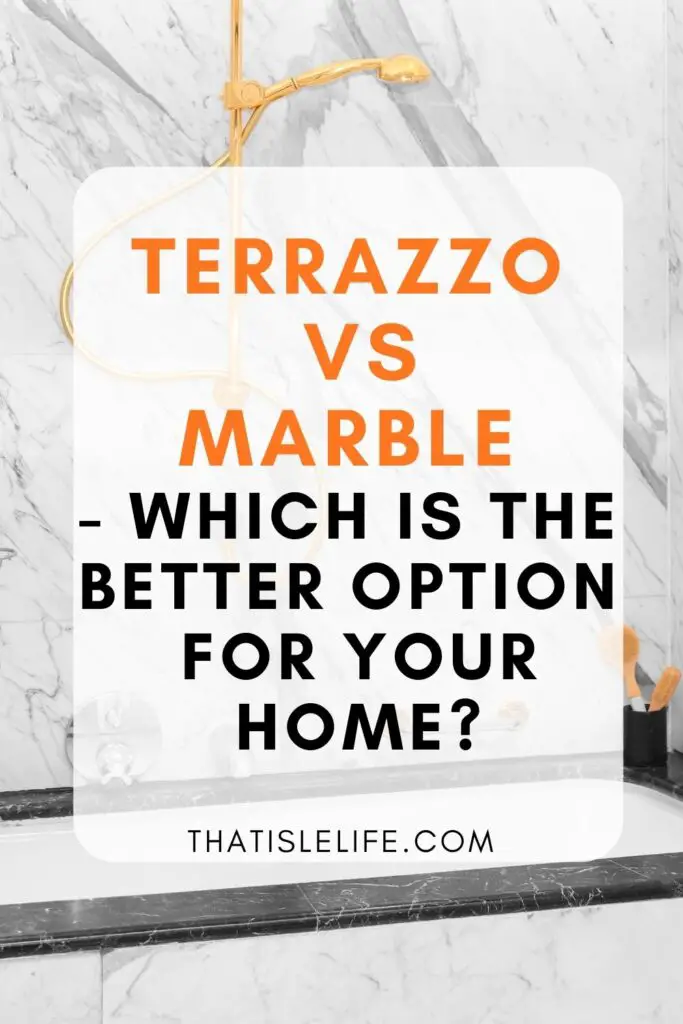
Related:
- Wicker vs Rattan – What’s the difference and why does it matter?
- Blinds vs Curtains: Which Window Treatment Is Better For Your Home?
What is terrazzo?

The name terrazzo is derived from the Latin word terra, which means ground. According to Elle Decor, terrazzo is a composite material of marble chippings set into cement. These days, you can find marble, glass, mother of pearl, and other chips in terrazzo.
Terrazzo stemmed from Italy during the 16th century because people wanted to recycle stone offcuts. You can find terrazzo in different forms:
- Poured on-site by hand
- Precast into blocks (usually cut into different sizes)
- Ready-made tiles
What is marble?
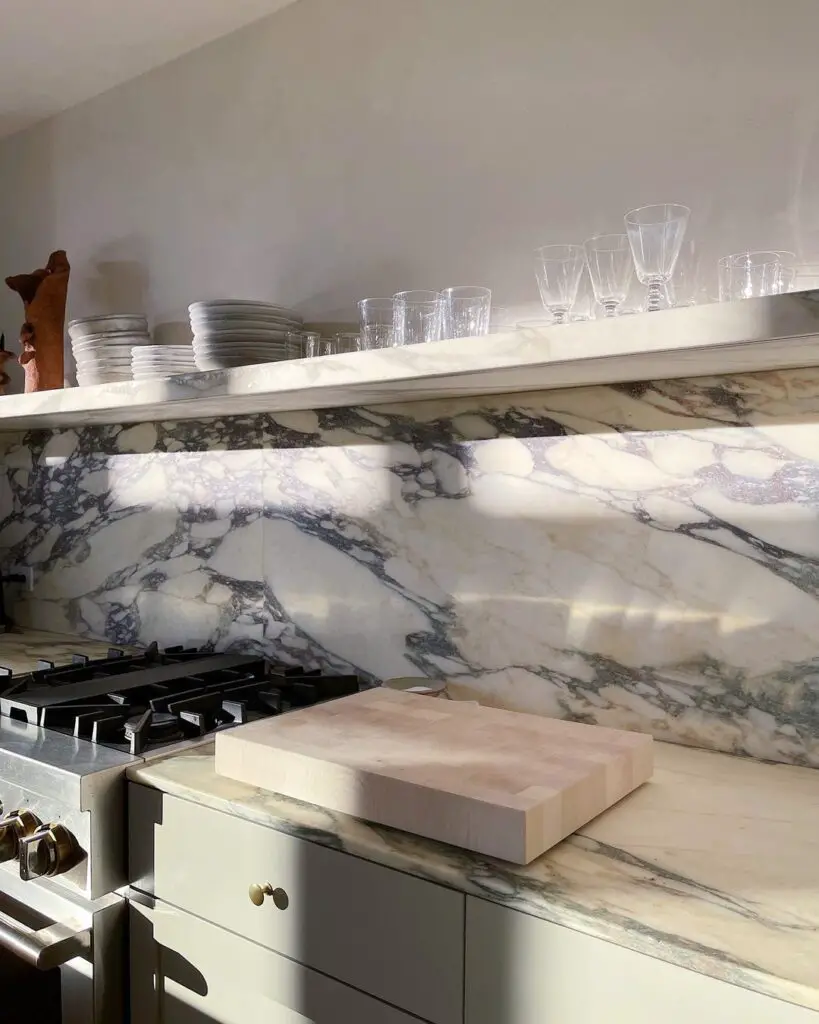
On the other hand, marble is a natural stone that is produced through the crystallization of limestone. The final result is a stone that has different veins on each piece, making them very unique.
According to Homedit, its name is derived from Greek words that mean shining stone. Marble reflects light beautifully and therefore has a beautiful shine or gleam to it. Its lustre is often associated with luxury.
Examples of terrazzo
Here are some common uses for terrazzo:
- Flooring
- Kitchen countertops
- Kitchen backsplashes
- Wall tiles
- Furniture
- Lighting and
- Home decor
Examples of marble
Here are some common uses for marble:
- Flooring
- Kitchen countertops
- Kitchen backsplashes
- Wall tiles
- Stairs
- Columns
- Sculptures
- Furniture and
- Home decor
Pros of terrazzo
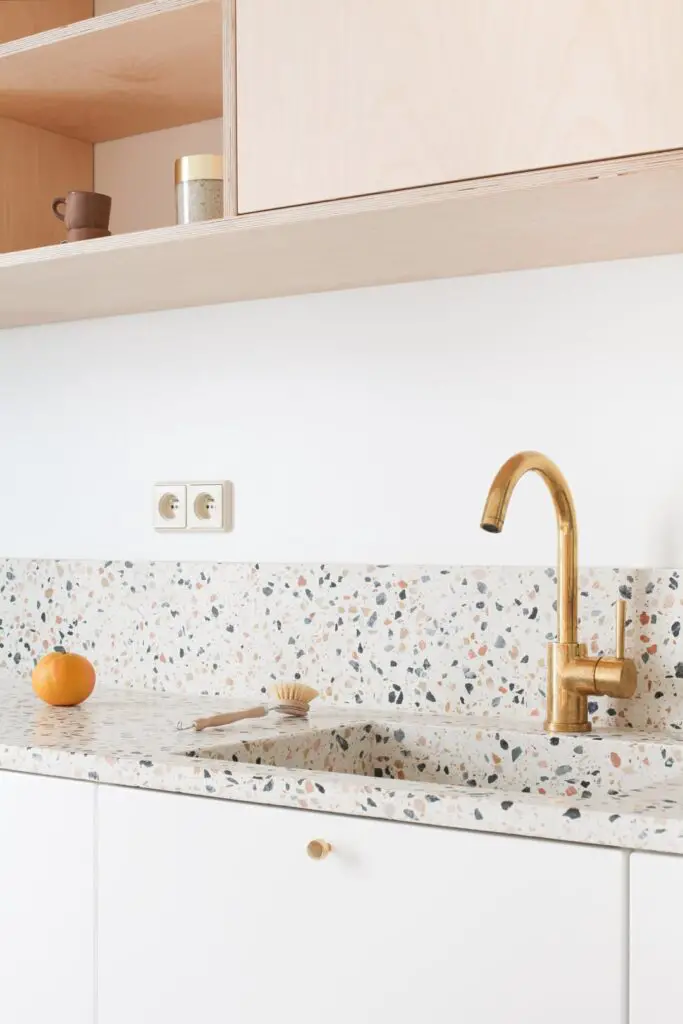
Visually attractive
It’s no surprise that terrazzo has seen a major comeback because it looks beautiful on any surface. Although it may not be as shiny as marble, its display of speckled color is visually attractive. It is the simplest way to add a splash of color in a neutral setting.
Durable
Terrazzo is not fragile despite being a thinner material than marble. It does not crack, chip, or stain easily. Once installed, it can last for many years without any repairs. Its sturdiness makes it perfect for flooring or kitchen countertops.
Versatile
Terrazzo is extremely versatile. You can mix different stone chips to get the color and pattern of your choice. Additionally, terrazzo can be formed into any shape. This makes it an incredibly versatile material for home decor pieces.
Non-porous
Terrazzo is sealed thoroughly once the pieces set. Then, it is polished to create a smooth finish. This process makes the material non-porous and therefore helps to prevent air and liquid from penetrating through the tiles. The absence of water eliminates any chances of breeding mold over time.
Low-Maintenance
Terrazzo is one of the easiest materials to maintain. It does not absorb stains and only requires water to clean. As a result, terrazzo is suitable for flooring, especially in high-traffic areas.
Eco-friendly
Terrazzo is a sustainable material. There is less wastage because it is made from stone offcuts. Terrazzo also cleans well without the use of cleaning detergents, which makes this material environmentally friendly.
Affordable
Terrazzo is often less expensive than marble. It offers great value for money for all the benefits it provides.
Cons of terrazzo
Complex to install
Terrazzo requires professional installation to make sure that all the materials are mixed and incorporated correctly. Although the material is more affordable than marble, labor costs may add up.
Slippery and cold
Terrazzo flooring can be very slippery, which can cause falls and trips. It is also cold to touch, which may be uncomfortable during the colder months.
Pros of marble

Visually beautiful
There’s no doubt that marble is visually beautiful. It is synonymous with luxury and style. Besides that, polished marble floors reflect light giving it a natural shine that is simply stunning.
Unique
Marble comes in a variety of colors and styles. Its natural patterns, otherwise known as veins, are what make this stone unique. No one stone looks the same.
Cons
Not durable
Marble is one of the most fragile natural materials. It is a porous material and is susceptible to staining, scratching, and chipping. Imperfections are obvious and they are hard to conceal.
Expensive
Marble is very costly to source, install and repair.
Hard to repair and maintain
Since each marble is unique, it is almost impossible to find the exact marble if a tile cracks or chips. In addition, marble is a high-maintenance material that requires frequent polishing to keep it shine.
Not sustainable
Marble is a natural material, which is mined from caves and quarries. It is part of Earth’s natural resources and may eventually be depleted over time.
Slippery and cold
Similarly to terrazzo, marble has a slippery surface that can result in accidents.
How to care for terrazzo
- Dust mop your terrazzo surfaces daily
- Use a damp mop and a neutral cleaner diluted in warm water weekly
- If needed, a stone expert can strip away old sealer and reseal terrazzo
- Stay away from harsh cleaning materials
How to care for marble
- Protect marble by not allowing certain things to sit on the stone. For instance, vinegar, citrus, and tomato will etch marble
- Use coasters and cutting boards for marble countertops
- Wipe spills up immediately
- Avoid using acidic or abrasive cleaners
- Reseal marble from time to time
- Spot treat with the right cleaners when necessary. The experts at Martha Stewart recommend using a poultice paste
Terrazzo home decor recommendations
Not sure if you prefer terrazzo vs. marble yet? Try purchasing small decor items first before you invest in big ticket items like flooring or countertops.
*Disclosure: I only recommend products I would use myself and all opinions expressed here are my own. This post may contain affiliate links that at no additional cost to you, I may earn a small commission. Read full privacy policy here.
Here’s a round-up of my favorite terrazzo pieces under $50:
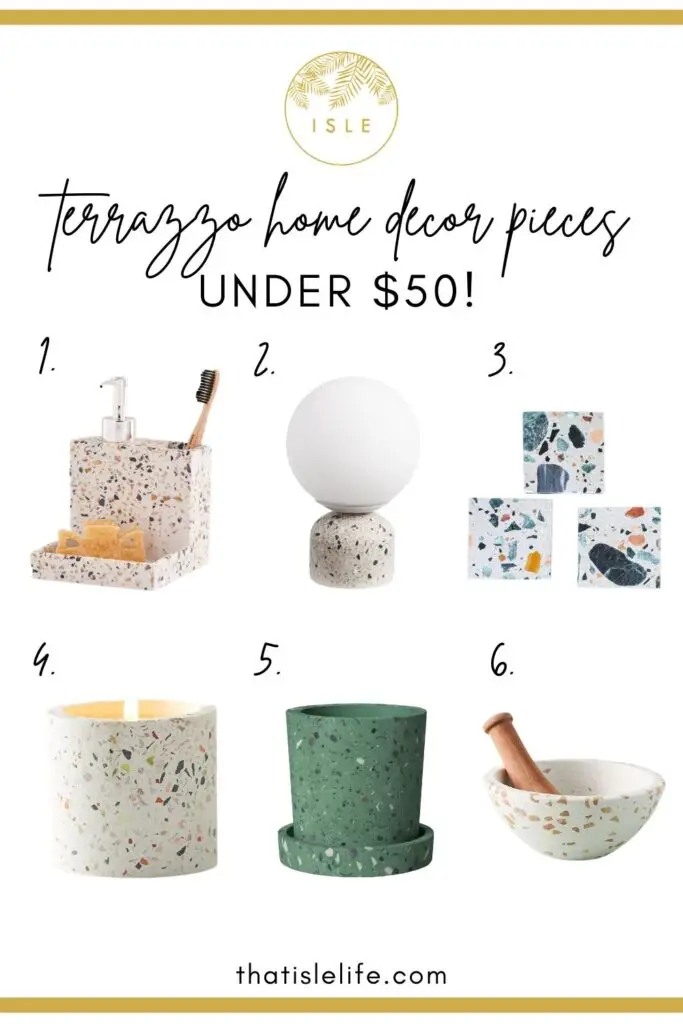
- Soap dispenser, $29
- Glass globe table lamp, $34.99 (on sale!)
- Coasters, 18
- Candle, $22
- Planter, $8
- Pestle and mortar, $32
Marble home decor recommendations
Here are some of my favorite marble pieces under $50:
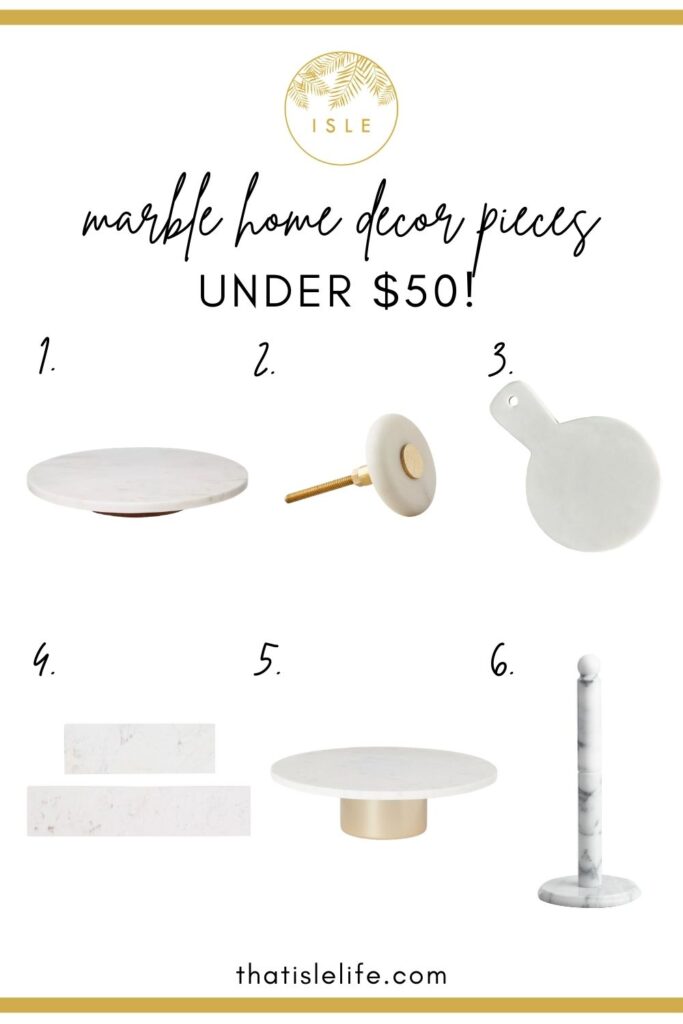
- Lazy Susan, $30
- Brass and marble knob, $16
- Mini picnic cheese board, $18-$20
- Mix and match wall shelf, $39.99-41.99 (sold out, similar here)
- Cake stand, $34.99
- Paper towel holder, $14.99
I hope this post has helped you to decide between terrazzo vs. marble! I love both materials but will probably choose terrazzo for high-traffic areas in my home.
Whichever you choose, always treat both materials with care and respect so they will last for ages.
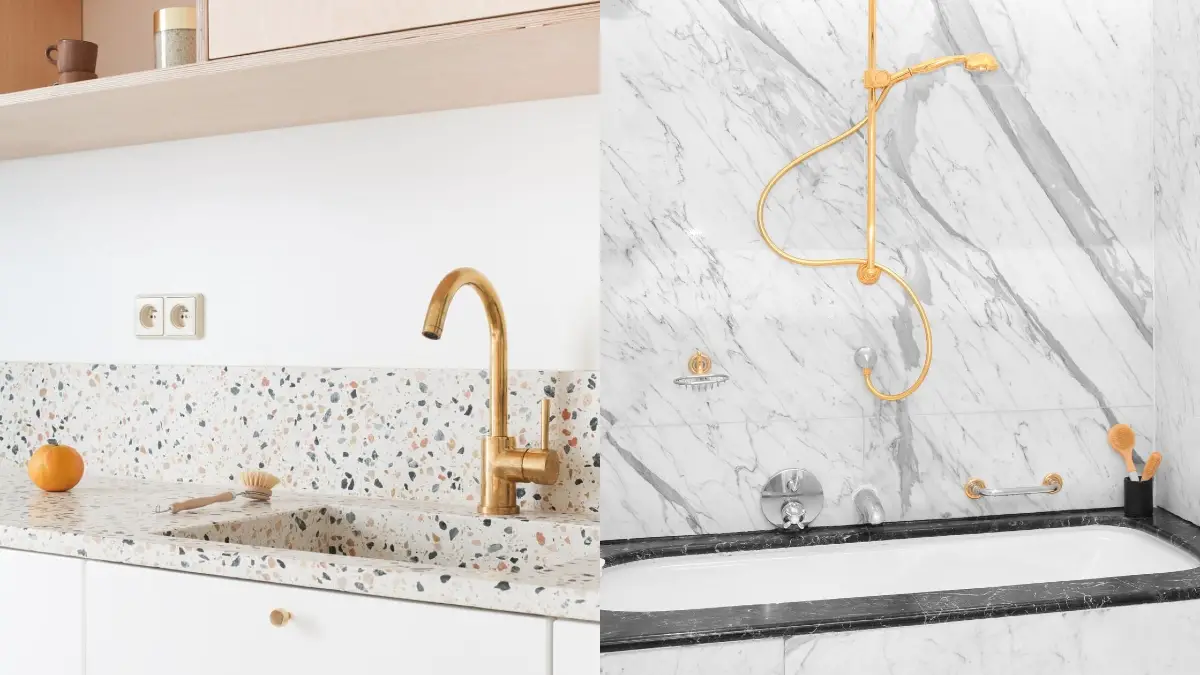
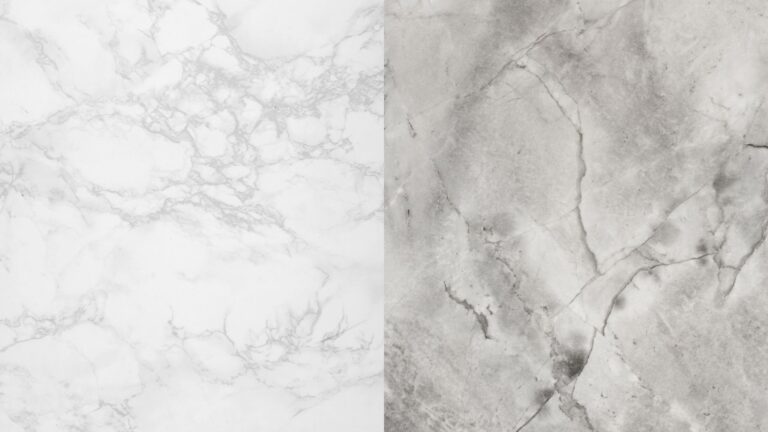
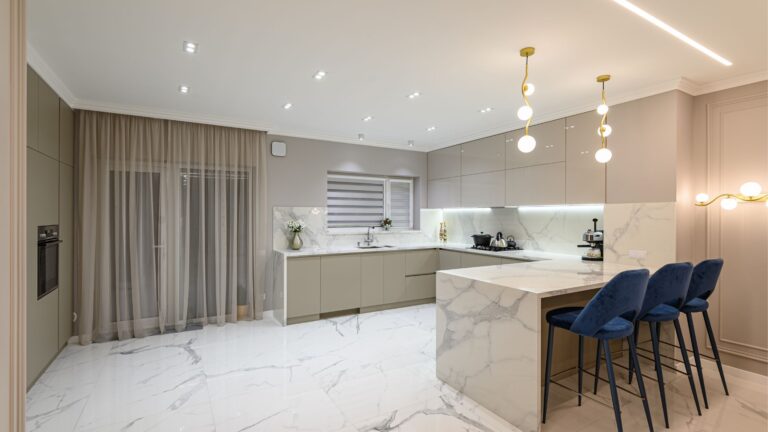
4 Comments